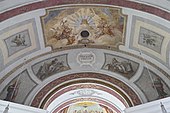St. Georg (Ruhpolding)
The Catholic parish church of St. Georg in Ruhpolding , a municipality in the Upper Bavarian district of Traunstein , was built in the first half of the 18th century in the Rococo style. The church is dedicated to St. George , the martyr and dragon slayer, who is also venerated as one of the fourteen helpers in need. A Romanesque Madonna figure from the 13th century is kept in the church. The church is one of the protected architectural monuments in Bavaria.
history
The forerunners of the Ruhpolding parish church were originally raised above the village in the mountain cemetery . In 1738 the dilapidated old Georgskirche from Gothic times was demolished and today's cemetery chapel was built in its place , in which Chancellor Georg von Hertling, among others, was buried and which was redesigned in 1957 as a crypt chapel for the Ruhpolding clergy.
After the demolition of the old church, the construction of the new parish church began in the same year, further down at its current location, as the old location did not offer enough space for the much larger new building. The plans were drawn up by the electoral court architect Johann Baptist Gunetzrhainer (1692–1763). In 1754 the new parish church was consecrated by Franz Karl Eusebius von Waldburg-Friedberg and Trauchburg , the bishop of the then Chiemsee diocese , which was under the archbishopric of Salzburg ; Ruhpolding was part of the church of Salzburg until 1817. The tower was completed in 1757.
architecture
Exterior construction
The church is laid out as an elongated hall with a strongly drawn-in choir . Low sacristies are added to either side of the choir . The bell tower crowned with a double onion rises on the west facade . The entire nave with tower is almost 51 meters long and about 19 meters wide. The nave is oriented to the south-east.
inner space
The interior is structured by wide pillars with strong beams . The corners of these pillars are filled with pilasters decorated with capitals . The choir, which is straight on the outside and semicircular on the inside, is covered by a dome , the nave with a length of 40 meters carries a needle cap barrel supported by arches . A double gallery forms the western end of the nave , on which the organ is housed above .
Ceiling paintings
The ceiling frescoes in the nave are based on the Rococo style and were executed in 1821 by Sebastian Rechenauer the Younger. The large picture on the ceiling depicts the resurrection of Christ , the smaller the adoration of the Lamb . Above the organ gallery you can see the decapitation of St. George, the patron saint of the church. The ceiling painting in the choir from 1873 is about the Last Supper .
Furnishing
- The most important sculpture in the church is the so-called Ruhpolding Madonna, an enthroned figure of Mary with a baby Jesus from the period 1220/30. It is kept in a golden niche in the right side altar.
- The high altar with its twisted columns frames a painting depicting St. George, the extract depicts the Immaculate Conception . Both pictures, like the altar leaves on the side altars, were made by the Landshut painter Matthias Daburger and are marked 1749. The carved figures in the Rococo style represent the two archangels Michael and Raphael , who accompanies the young Tobias . The two bishops, St. Benno , the bishop of Meissen and patron saint of Munich, and St. Rupert , the bishop of Salzburg , are as Representatives of the cities of Munich and Salzburg understand.
- The two confessionals are marked with the year 1744. The small pictures are reminiscent of Mary Magdalene and the apostle Peter , two saints who have regretted their mistakes. Mary Magdalene is shown with her attributes , the cross, the ointment pot, the skull and a scourge. The rooster points to Peter's denial of Jesus.
- The splendid Rococo style pulpit is decorated with several angel putti. The sound cover is crowned by the figure of the Good Shepherd , the pulpit is decorated with the four evangelists John , Luke , Mark and Matthew , who can be recognized by their symbols .
- Under the pulpit is a baptismal font with a group of sculptures depicting the baptism of Jesus .
- The crucifix on the opposite wall used to hang under the triumphal arch . The two assistant figures are the apostles Peter and Maria Magdalena. Three angels with goblets float under the cross to collect the blood of Jesus.
- Procession poles are set up under the crucifix .
- The pews still have numerous church chair signs from the 18th and early 19th centuries.
organ
The first organ in the Church of St. Georg was built in 1795 by the organ maker Andrä Mauracher von Karpfing. Today's Staller organ replaced a previous instrument from 1907 in 1981. On February 11, 1979, the organ builder Anton Staller received the order for the new technical construction, whereby the historic organ case by Johannes Schneider from 1795 was retained. The organ has 28 stops on two manuals and pedal , mechanical tone and electrical stop action.
|
|
|
|||||||||||||||||||||||||||||||||||||||||||||||||||||||||||||||||||||||||||||||||||||||||||||||
literature
- Georg Dehio : Handbook of the German art monuments. Bayern IV: Munich and Upper Bavaria . 2nd edition, Deutscher Kunstverlag, Munich 2002, ISBN 3-422-03010-7 , p. 1042.
- Ruhpolding . (= Little Art Guide No. 28). 9th modified edition, Verlag Schnell and Steiner, Regensburg 1995.
Web links
Individual evidence
- ↑ List of monuments for Ruhpolding (PDF) at the Bavarian State Office for Monument Preservation, monument number D-1-89-140-10
- ↑ derChiemgauer.de: Ruhpoldinger Chronik. Retrieved January 16, 2017 .
- ^ Richard Krekel: Church music St. Georg, Ruhpolding. Retrieved January 16, 2017 .
Coordinates: 47 ° 45 ′ 43.7 " N , 12 ° 38 ′ 31.5" E













